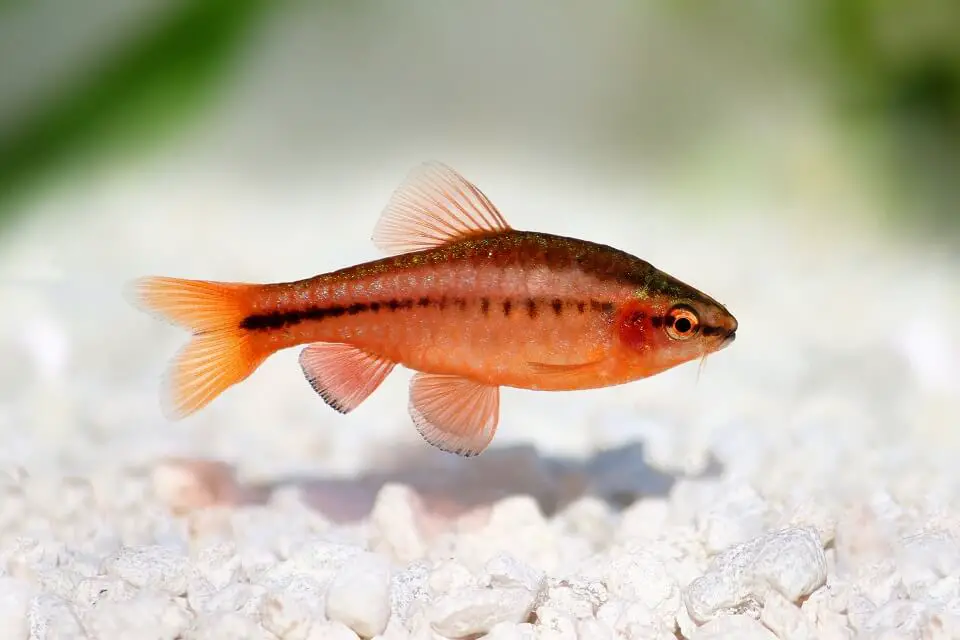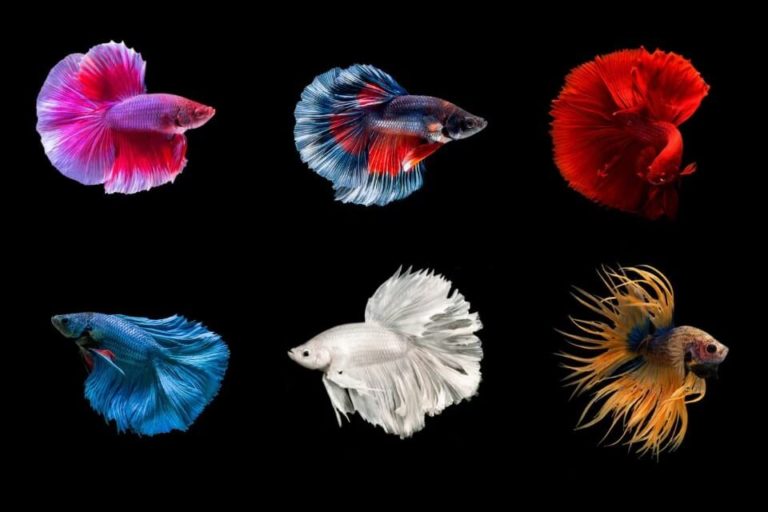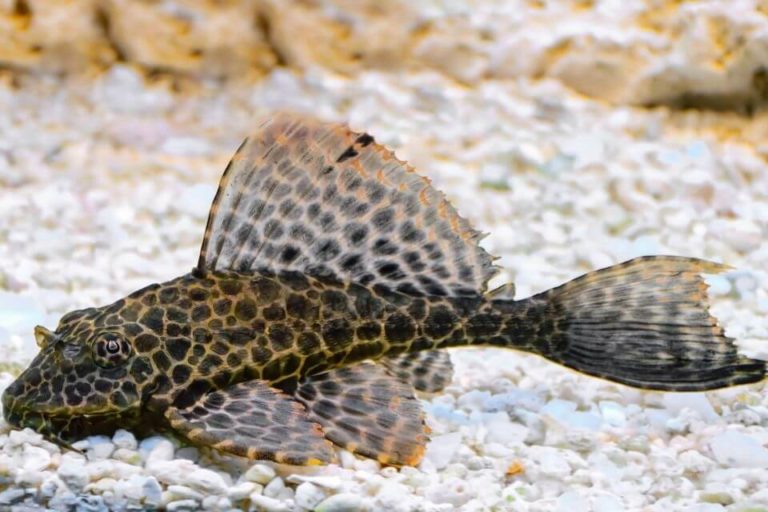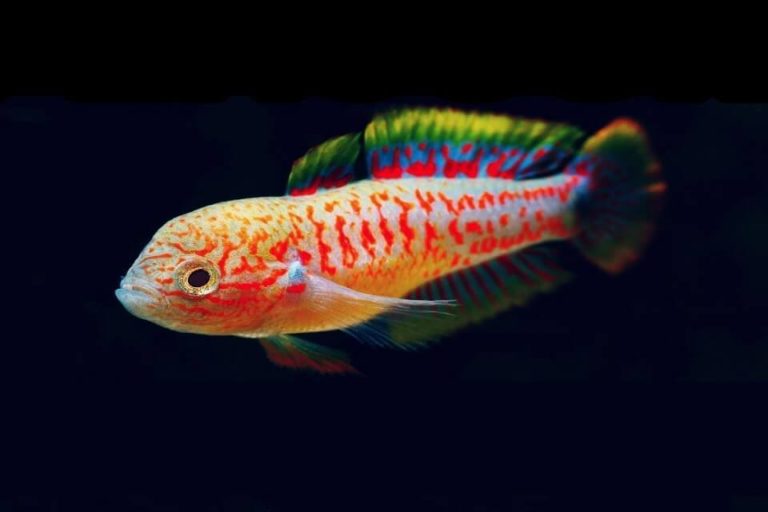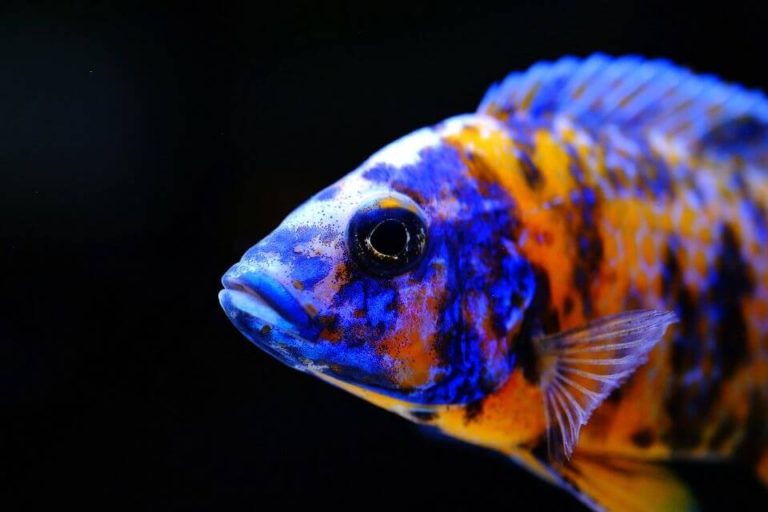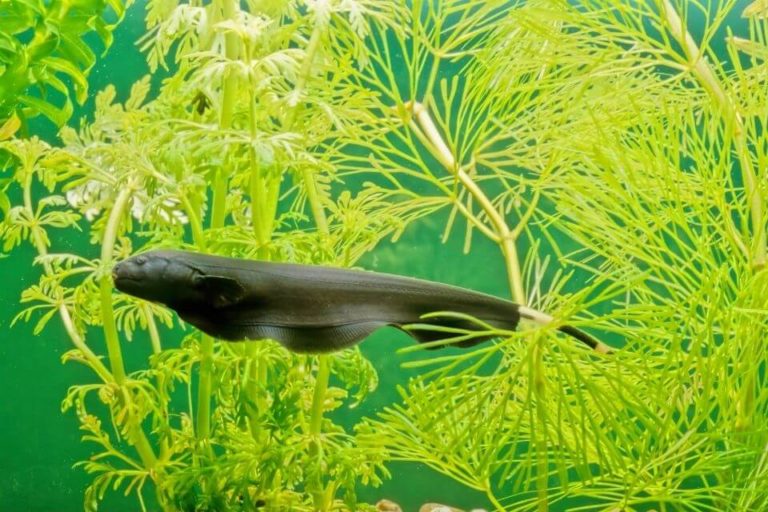Leopard Frog Pleco Care: Tank Setup, Tankmates, Feeding & More

Leopard Frog Pleco (L134) is a popular freshwater fish among aquarists due to its striking appearance and manageable care requirements which we can keep in a minimum of 30-gallon fish tank.
Leopard Frog Pleco is a peaceful species that can thrive in a well-maintained aquarium.
In this care guide, we will explore the essential aspects of Leopard Frog Pleco care and provide a comprehensive species profile to help you create an optimal environment for these fascinating fish.
Species Overview
Leopard Frog Plecos, scientifically known as Peckoltia pulcher, are small, peaceful freshwater fish originating from the Amazon River basin in South America.
These captivating creatures are named for the striking leopard-like spots that adorn their olive to brownish-gray bodies.
Understanding their natural habitat, physical characteristics, and behavior is crucial to providing them with the care and environment they need to thrive in home aquariums.
Leopard Frog Plecos are found in slow-moving rivers and creeks with rocky substrates, where they feed on algae and small invertebrates.
They prefer areas with ample hiding spaces such as caves, crevices, and driftwood, as well as clean, well-oxygenated water. Replicating these conditions in captivity is essential to their well-being.
Leopard Frog Pleco Size
Understanding the size of Leopard Frog Plecos is essential for providing them with the best care possible.
Leopard Frog Plecos typically grow to around 4 to 5 inches in length when fully mature. However, it’s important to note that the size can vary based on factors such as genetics, diet, and the quality of their living conditions.
🐟 Growth Rate
As with many fish species, the growth rate of Leopard Frog Plecos can vary. Factors such as diet, water quality, and tank size can all impact how quickly they reach their full size.
Providing a nutritious diet and maintaining optimal tank conditions can support healthy growth and development.
🐟 Sizing Considerations
When preparing an aquarium for Leopard Frog Plecos, it’s crucial to consider their adult size. Providing ample space and hiding spots in the tank will ensure that these fish can thrive and express their natural behaviors.
Keep in mind that inadequate space can stunt their growth and lead to health issues.
🐟 Monitoring Size
Regularly monitoring the size of your Leopard Frog Plecos is important for identifying any potential health concerns. Sudden changes in size or growth patterns could indicate underlying issues that require attention.
By staying attentive to their size, you can better understand their overall well-being.
Leopard Frog Pleco Lifespan
Leopard Frog Plecos have an average lifespan of 8 to 10 years in captivity, but with proper care and optimal conditions, they can live up to 12 years or even more.
Understanding the factors that contribute to their longevity will help you provide the best care for these fascinating creatures.
🐟 Proper Diet and Nutrition
Ensure a well-balanced diet for your Leopard Frog Pleco by offering a variety of high-quality sinking pellets, algae wafers, and occasional treats like blanched vegetables.
A diverse diet enriched with essential nutrients and vitamins will contribute to their overall health and longevity.
🐟 Water Quality and Conditions
Maintaining pristine water quality is crucial for the well-being and longevity of Leopard Frog Plecos. Regular water changes, proper filtration, and stable water parameters are essential factors in ensuring a healthy environment for these fish to thrive.
🐟 Stress-Free Environment
Creating a stress-free habitat for Leopard Frog Plecos is vital for their longevity. Provide plenty of hiding places, driftwood, and live plants to mimic their natural habitat.
A comfortable and secure environment will help reduce stress and promote a longer lifespan.
🐟 Disease Prevention and Quarantine
Implementing a quarantine process for new additions to the aquarium can help prevent the spread of diseases, ultimately contributing to the longevity of your Leopard Frog Plecos.
Additionally, regular observation and swift action in addressing any signs of illness are crucial in maintaining their health and lifespan.
Leopard Frog Pleco Appearance And Colors
Leopard Frog Plecos are small freshwater fish known for their striking appearance and vibrant colors. Their unique patterns and coloration make them a popular choice for aquarium enthusiasts.
Let’s delve into the fascinating details of their appearance and colors.
🐟 Body Shape and Size
Leopard Frog Plecos have a sleek and elongated body shape, resembling a typical Plecostomus. They grow to an average size of 4 to 5 inches, making them a great addition to medium-sized aquariums.
Their streamlined bodies allow them to navigate easily through aquatic plants and decorations, adding a graceful presence to any tank.
🐟 Skin Pattern and Texture
The most distinctive feature of Leopard Frog Plecos is their intricate spotted pattern, resembling the markings of a leopard. These dark spots are set against a light, creamy background, creating a visually stunning display.
The skin texture is smooth and sleek, with a shimmering quality that catches the light as the fish moves, adding to their allure.
🐟 Color Variations
In addition to their classic leopard-like spots, Leopard Frog Plecos exhibit a wide range of color variations. From a creamy white base color to shades of golden-yellow and beige, each fish possesses its own unique blend of hues.
These colors intensify under proper tank lighting, creating a mesmerizing spectacle for onlookers.
🐟 Fin Displays
Leopard Frog Plecos sport distinctive fins that complement their overall appearance. Their dorsal and pectoral fins are adorned with hints of orange and red, adding a pop of color to their otherwise patterned bodies.
When in motion, these fins unfurl gracefully, further accentuating their beauty and elegance. Leopard Frog Plecos are truly a sight to behold, with their enchanting appearance and vibrant colors.
Their captivating patterns, sleek bodies, and brilliant hues make them a valuable addition to any freshwater aquarium, captivating both seasoned aquarists and beginners alike.
Leopard Frog Pleco Behavior & Temperament
Leopard Frog Plecos (L134) are renowned for their peaceful and non-aggressive nature, making them an optimal addition to community aquariums.
They are known for their shy disposition, often seeking refuge in caves and crevices. However, upon acclimation to their environment, they become more active and visible, showcasing their distinct behaviors.
🐟 Territoriality
Leopard Frog Plecos are not territorial and typically coexist harmoniously with other fish species. They are not inclined to engage in confrontations and prefer to maintain a low profile within the tank.
🐟 Activity Patterns
Initially, Leopard Frog Plecos may exhibit nocturnal tendencies, preferring to explore and forage during the night.
However, as they adjust to their surroundings and feel secure, they become more active during the day, gracefully navigating the tank’s nooks and crannies.
🐟 Compatibility
Their peaceful demeanor makes them compatible with a wide range of tankmates, including peaceful community fish and other non-aggressive bottom-dwelling species.
However, it’s essential to consider their specific habitat requirements to ensure a harmonious cohabitation.
🐟 Social Behavior
Leopard Frog Plecos are not particularly social with their own species, but they do not display aggression towards other tankmates.
They are generally independent and content in the presence of other fish, contributing to the overall tranquility of the aquarium environment.
🐟 Response to Environment
These plecos are sensitive to abrupt changes in water parameters and may exhibit stress-related behavior in response. Ensuring a stable and suitable habitat is essential for maintaining their well-being and fostering their natural behaviors.
Incorporating hiding spots and driftwood in the aquarium mimics their natural habitat, providing them with a sense of security and promoting their natural behaviors.
Understanding and accommodating their behavioral traits can lead to a thriving and harmonious aquatic community.
Leopard Frog Pleco Care and Tank Setup
🐟 Tank Size
When setting up a tank for your Leopard Frog Pleco, it’s essential to consider the tank size. Aim for a capacity of at least 30 gallons tank to provide ample space for these active and sociable fish.
A larger tank, such as a 40-gallon breeder tank, can accommodate a small group of Leopard Frog Plecos and allow for more natural behavior.
🐟 Tank Setup
Substrate
For the substrate, opt for fine sand or rounded gravel to mimic the Plecos’ natural habitat. A soft, sandy substrate prevents injuries to their delicate barbels and allows them to exhibit their natural foraging behavior.
Lighting
Leopard Frog Plecos prefer subdued lighting, so it’s best to provide dim, ambient lighting in the aquarium. Utilize floating plants or tall decorations to create shaded areas for the Plecos to retreat to during the day.
Water Filter and Decorations
A quality canister filter with a gentle flow is ideal for maintaining pristine water conditions without causing too much disturbance.
Additionally, incorporate natural decor such as smooth rocks, caves, and driftwood to create hiding spots and territories for these shy fish.
🐟 Water Parameters and Testing
Maintaining stable water parameters is crucial for the well-being of Leopard Frog Plecos.
- Aim for a pH range of 6.5 to 7.5
- Water temperature between 75°F to 86°F
- Maintain water hardness from 6 to 10 dKH
Regularly test the water parameters using reliable test kits to ensure optimal conditions for your Plecos.
🐟 Suitable Aquarium Plants
When selecting live plants for the aquarium, consider species that can thrive in the Plecos’ preferred water parameters.
Anubias, Java Fern, and Amazon Sword plants are excellent choices, as they provide cover and grazing surfaces while being relatively undemanding in terms of care.
Common Diseases And Prevention
Leopard Frog Plecos are generally hardy fish, but they can still be susceptible to certain diseases.
Being able to identify these diseases early on can be crucial in preventing them from spreading through your aquarium. Here are some common diseases to watch out for and how to prevent them:
1. Ich (White Spot Disease)
Ich is a common freshwater fish disease caused by the Ichthyophthirius parasite. It presents as white spots on the fish’s body and fins, resembling grains of salt.
To prevent Ich, ensure that water parameters are stable, and maintain good water quality through regular water changes and proper filtration.
2. Fin Rot
Fin rot is a bacterial infection that causes the fins to appear ragged or frayed. It can be caused by poor water quality, so maintaining a clean aquarium environment is crucial.
Ensure that you remove any uneaten food and debris from the tank to prevent the buildup of harmful bacteria.
3. Swim Bladder Disorder
Leopard Frog Plecos can be prone to swim bladder issues, which can cause buoyancy problems. Prevention involves providing a well-balanced diet and avoiding overfeeding.
Incorporating sinking pellets into their diet can also help alleviate this issue.
4. Velvet Disease
Velvet is a parasitic infection that gives the fish’s skin a dusty or velvety appearance. It’s essential to quarantine any new fish before introducing them to the main tank to prevent the spread of velvet and other potential diseases.
5. Prevention Tips
- Quarantine new fish before adding them to your main tank.
- Maintain stable water parameters and good water quality.
- Avoid overfeeding and remove any uneaten food promptly.
- Observe your Leopard Frog Plecos regularly for any signs of distress or unusual behavior.
Leopard Frog Pleco Diet And Feeding
Leopard Frog Plecos are omnivores, meaning they eat both plant matter and meat. Providing a well-rounded diet is essential for their health and vitality. Here’s a closer look at the key aspects of their diet and feeding regimen.
🐟 Diet Composition
The diet of the Leopard Frog Pleco should consist of a variety of foods, including high-quality sinking pellets, algae wafers, blanched vegetables such as zucchini, cucumber, and spinach, as well as occasional live or frozen treats like bloodworms and brine shrimp.
This diverse diet helps mimic their natural feeding habits and ensures they receive the essential nutrients they need to thrive.
🐟 Feeding Frequency
Feeding Leopard Frog Plecos once a day is typically sufficient. However, it’s essential to monitor their individual eating habits and adjust the feeding frequency as needed.
Overfeeding can lead to health issues, so it’s crucial to provide an appropriate amount of food based on their appetite and nutritional requirements.
🐟 Feeding Tips
To accommodate their nocturnal nature, consider feeding them in the evening or before turning off the aquarium lights. This allows them to feed when they are most active, promoting natural behavior and optimal digestion.
Additionally, incorporating a feeding schedule and observing their response to different foods can help fine-tune their diet for maximum health and vitality.
🐟 Dietary Supplements
Supplementing their diet with occasional treats such as live or frozen foods can provide essential proteins and variety. However, moderation is key, as over-reliance on these treats can lead to imbalances in their overall diet.
A balanced approach ensures they receive the necessary nutrients while keeping mealtime interesting and engaging for these captivating creatures.
Incorporating a well-rounded diet and mindful feeding practices is essential for the overall well-being and vibrancy of Leopard Frog Plecos.
By understanding their dietary needs and feeding behaviors, aquarists can foster a healthy and thriving environment for these unique and captivating fish.
Leopard Frog Pleco Gender Difference
When it comes to Leopard Frog Plecos, understanding gender differences can be essential for their care and overall well-being. Here’s a breakdown of how to distinguish between male and female Leopard Frog Plecos.
🐟 Physical Characteristics
- Size: Male Leopard Frog Plecos are generally smaller and more slender compared to their female counterparts. Females tend to have a fuller and rounder body shape, especially when viewed from above.
- Coloration: In some cases, male Leopard Frog Plecos may exhibit brighter coloration, while females could have a more subdued appearance. However, this may not be a reliable indicator as coloration can vary among individuals.
🐟 Behavioral Cues
- Territorial Behavior: Male Leopard Frog Plecos are often more territorial and can be observed defending their space within the aquarium. Females may also display territorial behavior, but it’s typically less pronounced compared to males.
- Social Interaction: Females might exhibit more social behaviors, especially during breeding periods. They may also display maternal instincts by tending to their eggs and protecting their offspring.
Understanding these gender differences can contribute to creating a harmonious environment for Leopard Frog Plecos in a home aquarium.
Breeding Leopard Frog Pleco
Breeding Leopard Frog Plecos can be a rewarding experience for aquarists, but it requires careful planning and attention to detail.
From creating the ideal breeding environment to caring for the fry, there are several key factors to consider when attempting to breed these unique and captivating fish.
🐟 Creating the Ideal Breeding Environment
To encourage Leopard Frog Plecos to breed, it’s essential to replicate their natural habitat as closely as possible. This involves providing them with suitable caves or hiding spots where they can spawn and care for their eggs.
Utilize driftwood, PVC pipes, or ceramic caves to offer ample breeding sites within the aquarium. Maintaining a clean and well-oxygenated tank with stable water parameters is crucial for successful breeding.
🐟 Spawning Behavior and Care
When the breeding environment is set, observe the plecos for signs of courtship behavior, which may include males chasing females or displaying territorial behavior.
Once the plecos have spawned, carefully monitor the cave or spawning site to ensure the eggs are being cared for. The male pleco typically guards the eggs, and it’s essential to provide ample hiding spots and ensure the water quality remains pristine to support the development of the fry.
🐟 Rearing the Fry
After the eggs have hatched, the fry will require specific care to ensure their survival. Provide them with specialized fry food, such as powdered or liquid fry food, infusoria, or finely crushed flakes.
Maintaining optimal water conditions and minimizing stress in the tank is crucial for the health and development of the fry. As they grow, consider separating the fry into a separate tank to prevent predation and provide them with ample space to thrive.
Breeding Leopard Frog Plecos demands patience, attention to detail, and a deep understanding of their natural behaviors.
By creating a suitable breeding environment and providing meticulous care, aquarists can witness the fascinating process of new life emerging in your home aquarium.
Leopard Frog Pleco Tank Mates
If you’re considering adding a Leopard Frog Pleco to your aquarium, it’s crucial to choose suitable tank mates to ensure a harmonious aquatic environment.
Tank mates for Leopard Frog Plecos should be chosen thoughtfully to prevent conflict and provide a comfortable habitat for your aquatic pets. Here are some potential tank mates to consider:
🐟 Compatible Tank Mates
- Corydoras Catfish
- Ember Tetra
- Guppy Fish
- Cardinal Tetra
- Dwarf Gourami
- Pearl Gourami
- Honey Gourami
- Bristlenose Pleco
- Dwarf Cichlid
- Cherry Barb
🐟 Incompatible Tank Mates
- Cichlids: Avoid pairing Leopard Frog Plecos with aggressive cichlid species, as they may intimidate or harm the plecos.
- Large, Aggressive Fish: Predatory or boisterous fish should be avoided, as they can cause stress and potential harm to the Leopard Frog Pleco.
🐟 Considerations for Tank Mates
When selecting tank mates for your Leopard Frog Pleco, it’s essential to consider their size, behavior, and environmental needs.
Aim to create a community that offers a mix of bottom-dwellers, mid-level swimmers, and surface-dwelling fish to utilize the entire aquarium space effectively.
Additionally, ensuring that all tank inhabitants have compatible water parameter requirements is crucial for their well-being.
By carefully choosing compatible tank mates for your Leopard Frog Pleco, you can establish a thriving aquatic community that showcases the beauty and diversity of freshwater fish while fostering a balanced and tranquil ecosystem.
Leopard Frog Pleco Habitat And Distribution
Leopard Frog Plecos are native to the Amazon River basin in South America, specifically found in Brazil, Colombia, and Peru.
In the wild, these small, freshwater fish inhabit slow-moving rivers and tributaries, where they seek shelter in crevices, caves, and among submerged driftwood.
🐟 Natural Habitat
These plecos are commonly found in areas with moderate water flow, where the river or stream bed is lined with gravel, rocks, and submerged vegetation.
They thrive in dimly lit environments, often seeking refuge among fallen leaves and branches. The murky waters of their natural habitat provide the perfect cover for their distinct leopard-like markings.
🐟 Aquarium Habitat
When creating a habitat for Leopard Frog Plecos in an aquarium, it’s important to replicate their natural environment. Utilize driftwood, rocks, and live plants to mimic their native Amazonian surroundings.
Ensure there are plenty of hiding spots and caves for these shy fish to retreat to. Additionally, maintaining a slightly acidic pH level in the water and a temperature range of 75 to 86°F will closely resemble their natural habitat.
🐟 Geographic Distribution
Leopard Frog Plecos are distributed across various parts of the Amazon basin, with populations found in the Solimões River, the Amazon River itself, and its tributaries, including the Nanay River in Peru.
Their wide geographic range underscores their adaptability to diverse aquatic conditions, making them a hardy and sought-after species in the aquarium trade.
Frequently Asked Questions
» Is Leopard Frog Pleco Aggressive?
Leopard Frog Plecos are generally peaceful and non-aggressive. They can coexist with other fish species without causing trouble.
However, it’s essential to provide them with hiding spots in the aquarium to reduce stress and potential territorial behavior.
» How Many Leopard Frog Plecos Should Be Together?
It’s recommended to keep Leopard Frog Plecos in small groups of 3-5 individuals. They are social creatures and feel more secure in the presence of their own kind.
Providing adequate space and hiding spots will help minimize potential conflicts among them.
» Is Leopard Frog Pleco Hardy?
Yes, the Leopard Frog Pleco is a hardy and resilient species, making it suitable for beginner and experienced aquarists alike.
They can adapt well to various water conditions and are generally low-maintenance, adding to their appeal as aquarium pets.
» Do Leopard Frog Pleco Need Light?
Leopard Frog Plecos are nocturnal and prefer dimly lit environments. It’s crucial to maintain a balance by providing some light during the day while allowing for darkness at night.
Utilizing low-intensity aquarium lights or indirect room lighting can simulate their natural habitat.
» Does Leopard Frog Pleco Jump Out Of The Tank?
Although Leopard Frog Plecos are not known to be prone to jumping, it’s still important to have a secure lid on their tank. Opt for a tight-fitting lid to prevent any potential accidents and ensure their safety within the aquarium environment.
» How Much Does A Leopard Frog Pleco Cost?
The cost of Leopard Frog Plecos can vary based on their size and availability, but generally, they range from $20 to $50 per individual. Prices may fluctuate depending on factors such as age, size, and the specific market or supplier.
Conclusion
In conclusion, caring for Leopard Frog Plecos requires attention to water quality, diet, and tank setup.
By maintaining a clean environment, providing a varied diet, and creating suitable hiding spots, you can ensure the health and well-being of these unique and fascinating fish.
Remember to monitor water parameters regularly and make adjustments as needed. With proper care, Leopard Frog Plecos can thrive in your aquarium for many years to come.



